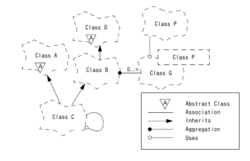Booch method
This article includes a list of references, related reading, or external links, but its sources remain unclear because it lacks inline citations. (March 2013) |

The Booch method is a technique used in software engineering. It is an object modeling language and methodology that was widely used in object-oriented analysis and design. It was developed by Grady Booch, while at Rational Software (now part of IBM).
The notation aspect of the Booch method has now been superseded by the Unified Modeling Language (UML), which features graphical elements from the Booch method along with elements from the object-modeling technique (OMT) and object-oriented software engineering (OOSE).
Methodological aspects of the Booch method have been incorporated into several methodologies and processes, the primary such methodology being the Rational Unified Process (RUP).
The Booch design methodology, like OMT, is extensively used and has ample documentation and support tools.
References
- Booch, Grady (1993). Object-oriented Analysis and Design with Applications (2nd ed.). Redwood City: Benjamin Cummings. ISBN 0-8053-5340-2.
- Martin, Robert Cecil (1995). Designing Object-Oriented C++ Applications using the Booch Method. Prentice-Hall. ISBN 0-13-203837-4.
